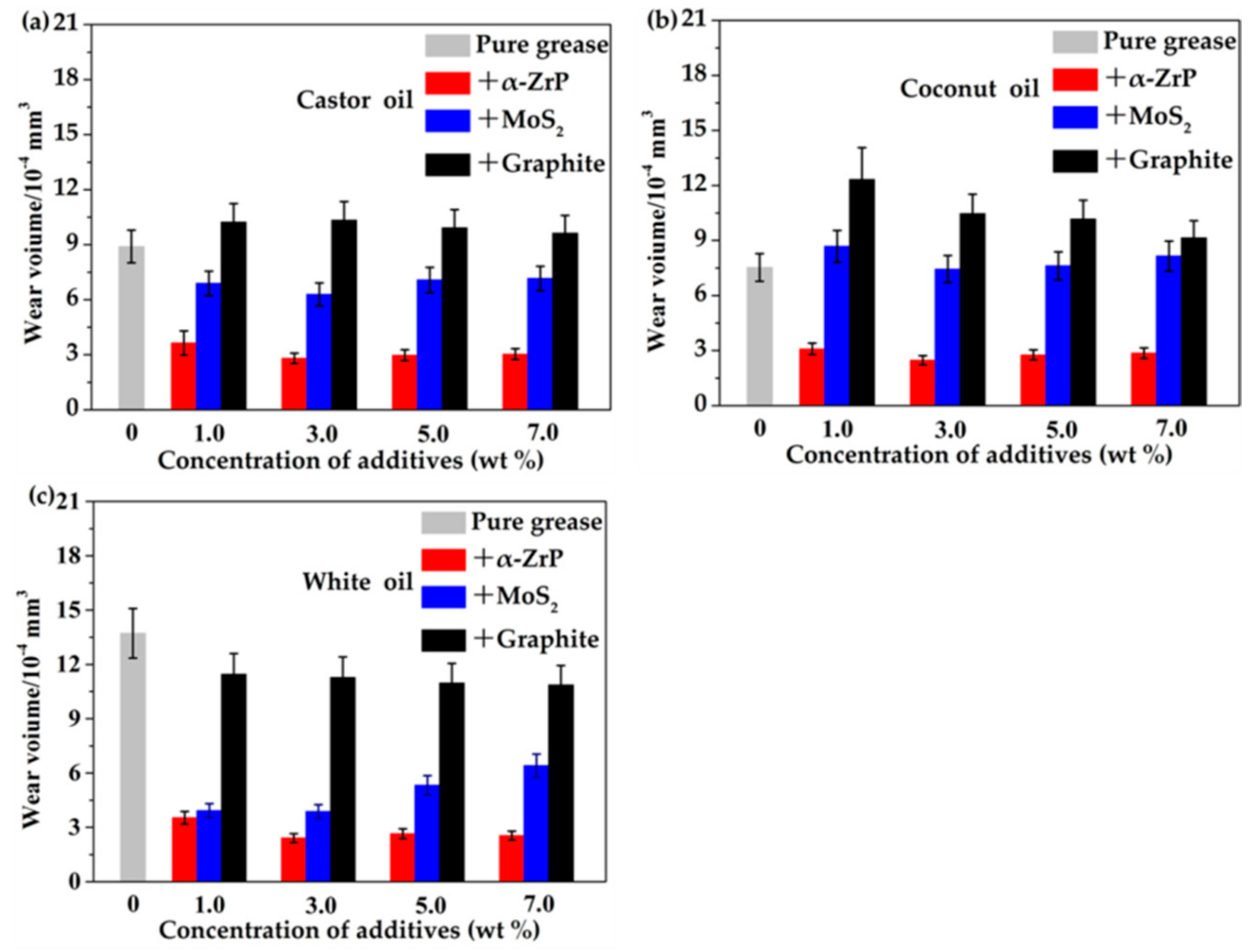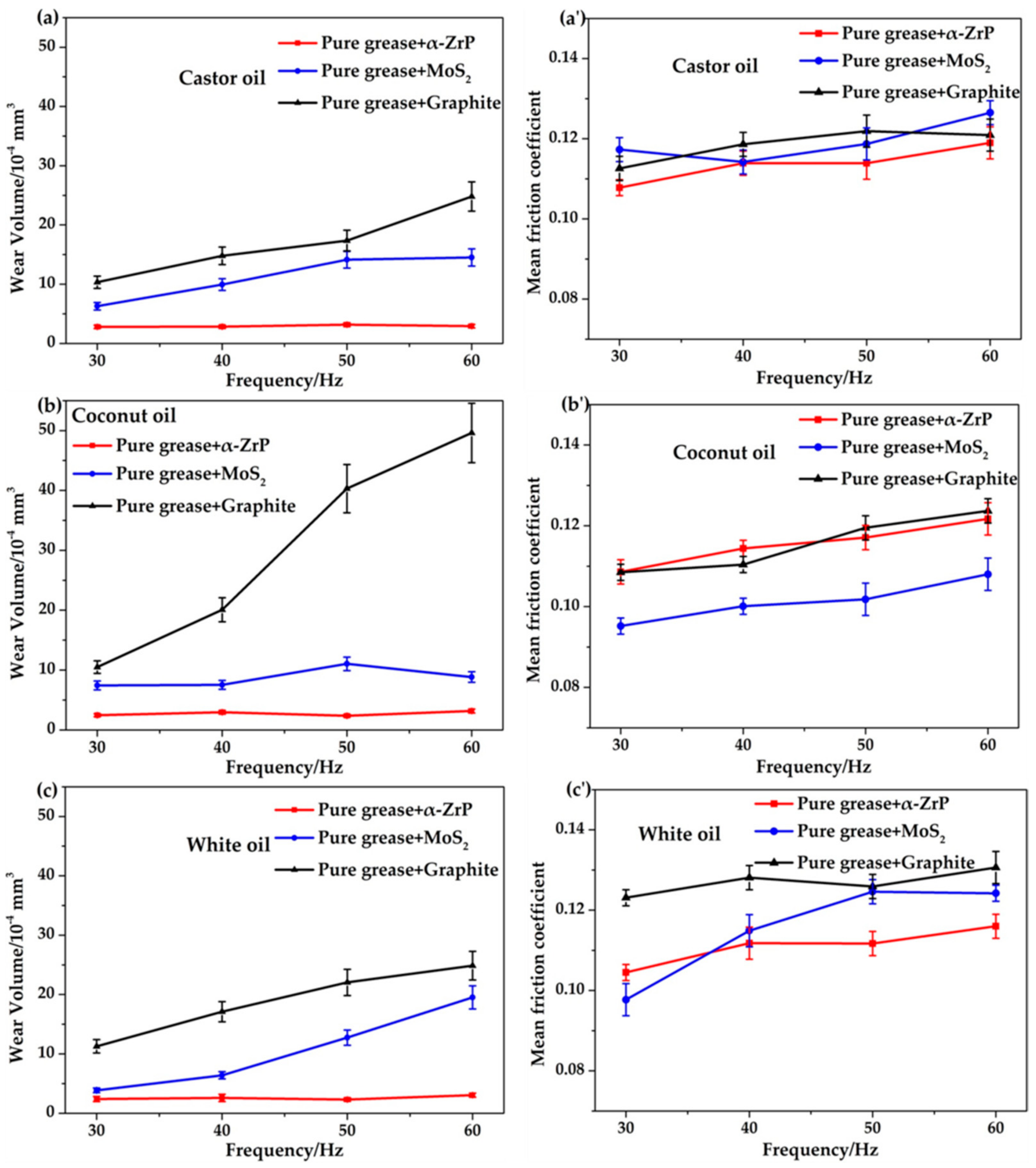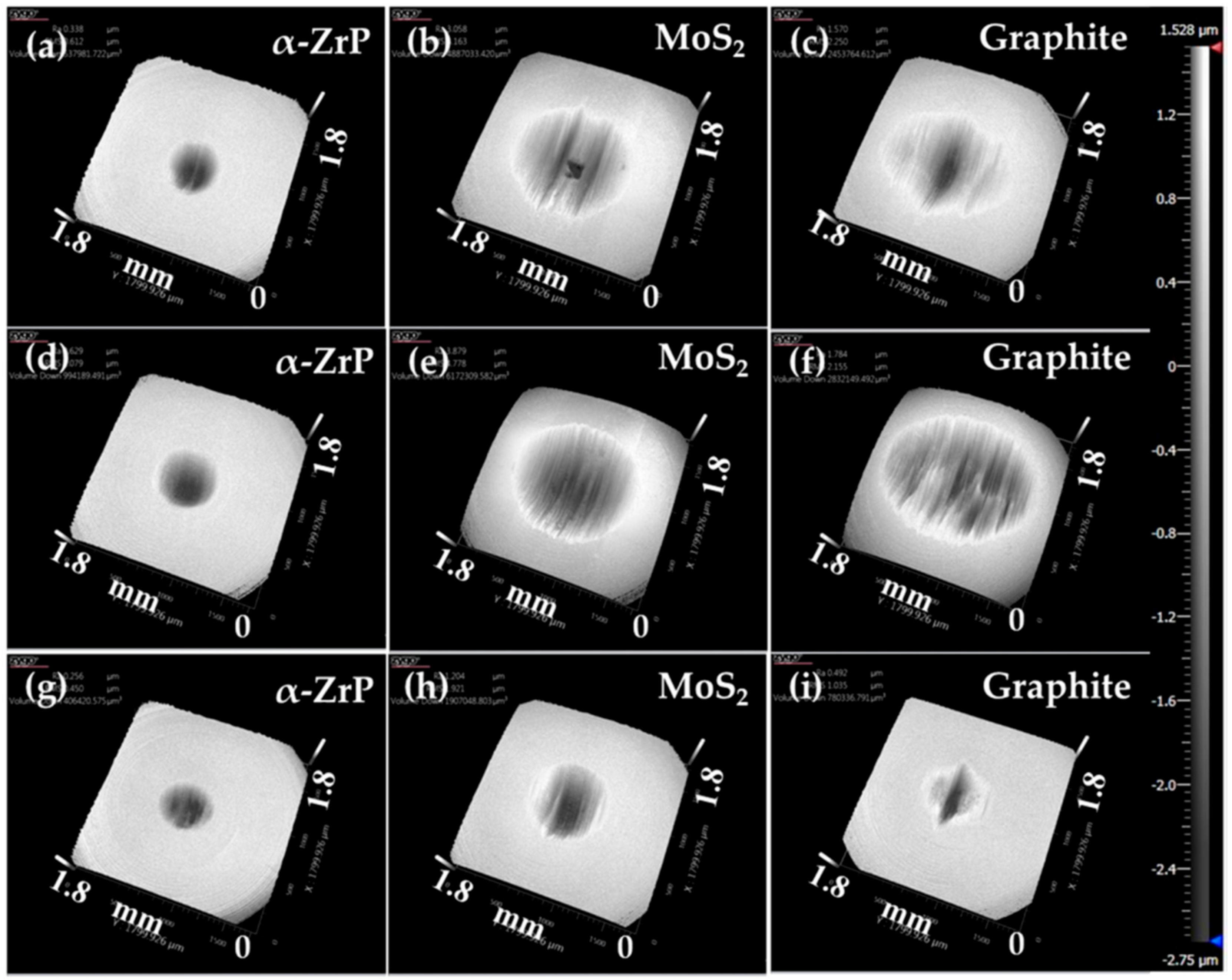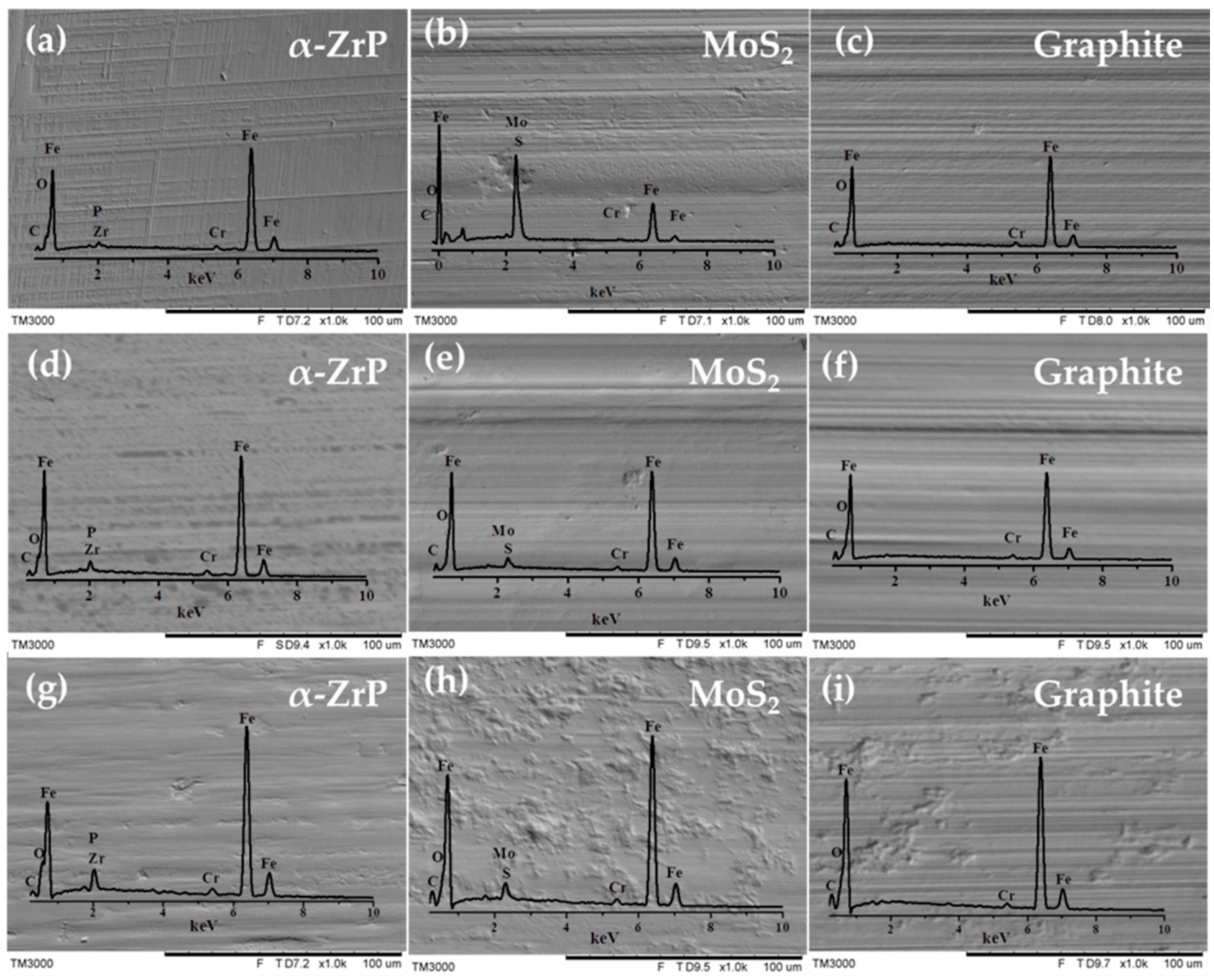Lubrication Performance of α-Zirconium Phosphates as an Anti-Wear Additive in Vegetable Oil-Based Anhydrous Calcium Grease
Abstract
1. Introduction
2. Experimental Section
2.1. Material
2.2. Tribological Test
2.3. Characterization and Analysis
3. Results
3.1. Effect of Additive Concentration
3.2. Effect of Applied Load
3.3. Effect of Reciprocating Frequency
3.4. Effect of Long Durations
4. Conclusions
- When the base oil is vegetable oil, the grease containing α-ZrP showed good performance in anti-wear and friction-reduction, as well as load-carrying capacity, regardless of the testing applied load and frequency.
- As the test time was extended from 30 to 360 min, α-ZrP grease could run steadily throughout the test, and had better anti-wear properties than those of graphite and MoS2 greases under the same test conditions.
- Compared with MoS2 and graphite, α-ZrP had better adaptability in vegetable oils.
Supplementary Materials
Author Contributions
Funding
Conflicts of Interest
References
- Betton, C.I. Lubricants and Their Environmental Impact. In Chemistry and Technology of Lubricants; Mortier, R.M., Fox, M.F., Orszulik, S.T., Eds.; Springer: Dordrecht, The Netherlands, 2010. [Google Scholar]
- Fuks, I.G.; Evdokimov, A.Y.; Dzhamalov, A.A.; Luksa, A. Vegetable oils and animal fats as raw materials for the manufacture of commercial lubricants. Chem. Technol. Fuels Oils 1992, 28, 230–237. [Google Scholar] [CrossRef]
- Hashem, A.I.; Abou Elmagd, W.S.I.; Salem, A.E.; El-Kasaby, M.; El-Nahas, A.M. Conversion of some vegetable oils into synthetic lubricants. Energy Sources Part A 2013, 35, 397–400. [Google Scholar] [CrossRef]
- Garcés, R.; Force, M.E.; Salas, J.J. Vegetable oil basestocks for lubricants. Grasas Y Aceites 2011, 62. [Google Scholar] [CrossRef]
- El-Adly, R.A.; Ahmed, H.B.; Modather, F.H. Jojoba and castor oils as fluids for the preparation of bio greases: A comparative study. Int. J. Sci. Eng. Res. 2014, 5, 755–762. [Google Scholar]
- Mannekote, J.K. Synthesis and characterization of coconut oil based non soap greases. In Proceedings of the International Conference on Industrail Tribology, Pune, India, 7–9 December 2012. [Google Scholar]
- Chtourou, M.; Trabelsi, M.; Frikha, M.H. Utilization of olive-residue oil in the formulation of lubricating calcium greases. J. Am. Oil Chem. Soc. 2004, 81, 809–812. [Google Scholar] [CrossRef]
- Boner, C.J. Manufacture and Application of Lubricating Greases; Reinhold: New York, NY, USA, 1954. [Google Scholar]
- Allison, J.R.; Blalock, W.L. Lubricating Grease. U.S. Patent 2,628,195, 10 February 1953. [Google Scholar]
- Bowden, F.P.; Tabor, D. The Friction and Lubrication of Solids; Oxford University Press: Oxford, UK, 2001; Volume 1. [Google Scholar]
- Liu, L.; Chen, Z.F.; Wei, H.B. Ionothermal synthesis of layered zirconium phosphates and their tribological properties in mineral oil. Inorg. Chem. 2010, 49, 8270–8275. [Google Scholar] [CrossRef] [PubMed]
- Zhang, X.; Xu, H.; Zuo, Z.; Lin, Z.; Ferdov, S.; Dong, J. Hydrothermal synthesis of copper zirconium phosphate hydrate [Cu(OH)2Zr(HPO4)2·2H2O] and an investigation of its lubrication properties in grease. ACS Appl. Mater. Interfaces 2013, 5, 7989–7994. [Google Scholar] [CrossRef] [PubMed]
- Chen, L.; Zhang, X.; Xu, H.; Dong, J. Tribological investigation of two different layered zirconium phosphates as grease additives under reciprocating sliding test. Tribol. Lett. 2016, 64. [Google Scholar] [CrossRef]
- Dai, Y.; Niu, W.; Zhang, X.; Xu, H.; Dong, J. Tribological investigation of layered zirconium phosphate in anhydrous calcium grease. Lubricants 2017, 5, 22. [Google Scholar] [CrossRef]
- Saxena, V.; Diaz, A.; Clearfield, A.; Batteas, J.D.; Hussain, M.D. Zirconium phosphate nanoplatelets: A biocompatible nanomaterial for drug delivery to cancer. Nanoscale 2013, 5, 2328–2336. [Google Scholar] [CrossRef] [PubMed]
- Sekhon, B.S.; Kamboj, S.R. Inorganic nanomedicine—Part 2. Nanomed. Nanotechnol. Biol. Med. 2010, 6, 612–618. [Google Scholar] [CrossRef] [PubMed]








| Materials | Size as Per Suppliers’ Data | Supplier |
|---|---|---|
| α-ZrP | particle size of 0.5–0.6 μm and thickness of 50–100 nm | Synthesized in our laboratory according to reported method [12] |
| MoS2 | particle size of 1.5–3.5 μm and thickness of 50–100 nm | DAI ZO Corporation of Osaka (Osaka, Japan) |
| graphite | particle size of 1 to 7.0 μm and thickness of 100 to 200 nm | Aoyu Graphite Factory of Jixi (Jixi, China) |
| SRV High-Frequency, Linear-Oscillating Tester | |
|---|---|
| Maker | Optimal |
| Contact of tribocouple and motion | Ball against disk reciprocating sliding motion |
| Specimens | AISI 52100 steel ball (Φ 10 mm, 59–62 HRC), AISI 52100 steel disk (Φ 24 mm, 59–62 HRC) |
| Output | Friction coefficient |
| Details of method | stroke length 1 mm, Frequency 30–60 Hz, test duration 30–360 min, at 80 °C and load 300–1000 N |
| Oil | Additive | Wear Volume (×10−4 mm3) | Mean Friction Coefficient |
|---|---|---|---|
| Castor oil | α-ZrP | 5.71 ± 0.86 | 0.110 ± 0.015 |
| MoS2 | 21.94 ± 2.19 | 0.113 ± 0.011 | |
| graphite | 18.30 ± 1.83 | 0.118 ± 0.012 | |
| Coconut oil | α-ZrP | 4.97 ± 0.75 | 0.101 ± 0.015 |
| MoS2 | 38.11 ± 3.81 | 0.099 ± 0.010 | |
| graphite | 22.00 ± 0.22 | 0.106 ± 0.011 | |
| White oil | α-ZrP | 5.32 ± 0.80 | 0.097 ± 0.015 |
| MoS2 | 35.05 ± 3.51 | 0.126 ± 0.013 | |
| graphite | 34.08 ± 3.41 | 0.123 ± 0.012 |
| Oil | Additive | Maximum Load (N) | Wear Volume (×10−4 mm3) |
|---|---|---|---|
| Castor oil | α-ZrP | 1000 | 21.30 ± 2.13 |
| MoS2 | 600 | 21.94 ± 2.19 | |
| graphite | 600 | 18.30 ± 1.83 | |
| Coconut oil | α-ZrP | 1000 | 8.83 ± 0.88 |
| MoS2 | 600 | 38.11 ± 3.81 | |
| graphite | 600 | 22.00 ± 0.22 | |
| White oil | α-ZrP | 700 | 7.01 ± 0.70 |
| MoS2 | 600 | 35.05 ± 3.51 | |
| graphite | 600 | 34.08 ± 3.41 |
| Oil | Additive | Wear Volume (×10−4 mm3) | Mean Friction Coefficient |
|---|---|---|---|
| Castor oil | α-ZrP | 2.92 ± 0.44 | 0.119 ± 0.018 |
| MoS2 | 14.52 ± 1.45 | 0.127 ± 0.013 | |
| graphite | 24.81 ± 2.48 | 0.121 ± 0.012 | |
| Coconut oil | α-ZrP | 3.17 ± 0.48 | 0.122 ± 0.018 |
| MoS2 | 8.84 ± 0.88 | 0.108 ± 0.011 | |
| graphite | 49.61 ± 4.96 | 0.124 ± 0.012 | |
| White oil | α-ZrP | 3.05 ± 0.46 | 0.116 ± 0.017 |
| MoS2 | 19.53 ± 1.95 | 0.124 ± 0.013 | |
| graphite | 24.86 ± 2.49 | 0.131 ± 0.013 |
© 2018 by the authors. Licensee MDPI, Basel, Switzerland. This article is an open access article distributed under the terms and conditions of the Creative Commons Attribution (CC BY) license (http://creativecommons.org/licenses/by/4.0/).
Share and Cite
Dai, Y.; Xu, H.; Dong, J. Lubrication Performance of α-Zirconium Phosphates as an Anti-Wear Additive in Vegetable Oil-Based Anhydrous Calcium Grease. Lubricants 2018, 6, 63. https://doi.org/10.3390/lubricants6030063
Dai Y, Xu H, Dong J. Lubrication Performance of α-Zirconium Phosphates as an Anti-Wear Additive in Vegetable Oil-Based Anhydrous Calcium Grease. Lubricants. 2018; 6(3):63. https://doi.org/10.3390/lubricants6030063
Chicago/Turabian StyleDai, Yingjing, Hong Xu, and Jinxiang Dong. 2018. "Lubrication Performance of α-Zirconium Phosphates as an Anti-Wear Additive in Vegetable Oil-Based Anhydrous Calcium Grease" Lubricants 6, no. 3: 63. https://doi.org/10.3390/lubricants6030063
APA StyleDai, Y., Xu, H., & Dong, J. (2018). Lubrication Performance of α-Zirconium Phosphates as an Anti-Wear Additive in Vegetable Oil-Based Anhydrous Calcium Grease. Lubricants, 6(3), 63. https://doi.org/10.3390/lubricants6030063




